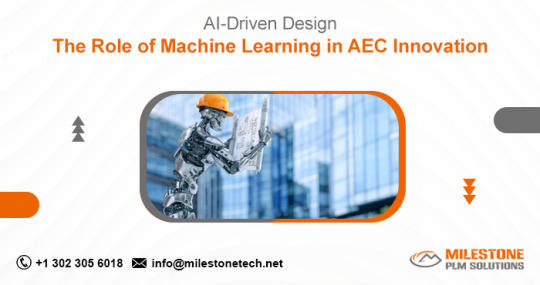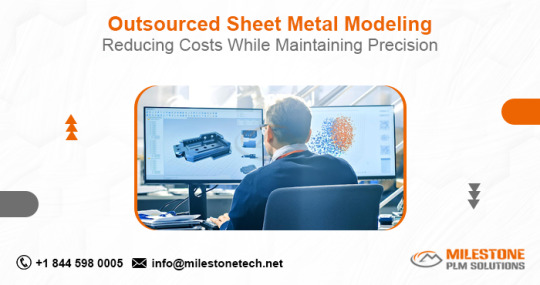Milestone PLM Solutions is a leading BIM & Engineering Design Services company providing BIM Services, pre-construction planning services, Engineering Design Services, Product Design servics to various Architecture and construction firms Engineering companies in the USA
Don't wanna be here? Send us removal request.
Text
AI-Driven Design: The Role of Machine Learning in AEC Innovation
The Architecture, Engineering, and Construction (AEC) industry is undergoing a profound transformation. From paper blueprints to digital Building Information Modeling (BIM), the sector has embraced innovation over time—but now, AI-driven design and machine learning (ML) are setting a new benchmark for how projects are conceived, managed, and executed.
In this blog, we explore how Machine Learning in AEC is reshaping workflows, boosting creativity, and enhancing collaboration across the entire project lifecycle.

What Is AI-Driven Design?
AI-driven design refers to the use of artificial intelligence algorithms to assist in or automate the design process. In the AEC industry, this involves analyzing vast datasets—site conditions, user behaviors, cost estimates, structural constraints, and more—to generate optimal design solutions. Machine learning, a subset of AI, empowers systems to learn from historical data and improve outcomes over time without explicit programming.
The Current Challenges in AEC
Before diving into the role of ML, it's essential to understand the key issues facing AEC professionals:
Fragmented Collaboration: Architects, engineers, and contractors often work in silos, leading to miscommunication and rework.
Inefficient Planning: Manual planning processes can’t keep up with today’s project complexity and scale.
Design Errors & Delays: Human-driven iterations are time-consuming and prone to oversight.
Cost Overruns: Inaccurate estimations often lead to budget overshoots.
This is where AI and ML technologies bring transformative potential.
How Machine Learning Is Driving Innovation in AEC
1. Generative Design
One of the most prominent applications of ML in AEC is generative design. By inputting constraints like budget, materials, site data, and performance goals, ML algorithms can generate hundreds—or even thousands—of design alternatives. This empowers architects and engineers to:
Quickly explore diverse design options
Optimize for factors like energy efficiency, material use, and spatial planning
Make data-backed decisions instead of relying solely on intuition
Autodesk, for instance, uses ML-based generative design tools that enable firms to reduce project time while maximizing functionality.
2. Predictive Analytics for Project Planning
Machine learning algorithms analyze past project data to forecast future outcomes. For example:
Timeline predictions based on similar project scopes
Budget forecasting by examining material cost fluctuations
Risk identification through site and environmental data
This helps project managers anticipate and address issues before they escalate, ensuring smoother execution.
3. Real-Time Collaboration & BIM Integration
Modern BIM platforms are now infused with AI to enable smarter coordination. ML algorithms detect design clashes, flag inconsistencies, and suggest improvements in real time. This leads to:
Fewer construction errors
Reduced rework
Stronger alignment between disciplines
ML also automates repetitive tasks like model validation, clash detection, and version comparison, giving teams more time to focus on strategic design work.
4. Smart Construction Monitoring
Machine learning is being used to monitor construction sites using drones, cameras, and IoT sensors. These technologies:
Track worker movements and safety compliance
Monitor equipment usage and material availability
Detect progress delays by comparing visual data to 3D BIM models
By applying ML to this data, stakeholders gain actionable insights to improve efficiency and safety on-site.
5. Sustainable Design Optimization
Sustainability is a growing priority in AEC. ML can help design more sustainable buildings by:
Predicting energy consumption and carbon impact
Recommending eco-friendly materials and configurations
Modeling climate-responsive designs using weather and terrain data
Firms that adopt ML-driven sustainability practices can meet green certifications like LEED faster and with greater accuracy.
Benefits of AI-Driven Design in AEC
Accelerated design cycles through automated iterations
Improved decision-making powered by data and simulations
Reduced costs from better forecasting and fewer errors
Enhanced creativity by exploring innovative design options
Greater client satisfaction due to visualizations and accurate planning
In essence, ML bridges the gap between human creativity and computational efficiency.
The Road Ahead: AEC and the Future of Machine Learning
While the AEC industry has historically been slower to adopt digital transformation compared to sectors like finance or healthcare, the tide is clearly turning. Startups and established players alike are integrating AI-driven platforms into their workflows to stay competitive.
In the future, we can expect:
AI to play a more proactive role in code compliance and permitting
ML to enable real-time cost and time optimization during construction
Augmented Reality (AR) combined with AI for immersive, intelligent site inspections
Investing in AI and ML capabilities today means preparing for an AEC future where speed, accuracy, and innovation are no longer trade-offs but expectations.
Conclusion
AI-driven design powered by machine learning in AEC is not just a trend—it’s a paradigm shift. By leveraging these technologies, the AEC industry can unlock new levels of collaboration, creativity, and sustainability. As projects grow in complexity and clients demand better outcomes, embracing AI is no longer optional—it's essential for staying ahead in a competitive landscape.
Whether you're an architect envisioning smarter buildings, an engineer optimizing structure, or a project manager balancing time and cost, machine learning offers tools to design the future—today.
0 notes
Text
Revolutionize Your Projects: AI Strategies to Cut Construction Costs and Time
Introduction: The AI Revolution in Construction
In the ever-evolving construction industry, delays and budget overruns have long been accepted as common challenges. However, with the rise of Artificial Intelligence (AI), these pain points are now being directly addressed. From pre-construction planning to on-site execution and post-construction maintenance, AI is not just a trend—it's a game changer. Companies that embrace AI strategies are finding themselves ahead of the curve, delivering projects faster and at lower costs.

1. AI-Powered Planning and Design Optimization
The first stage of any construction project—planning and design—sets the tone for everything that follows. AI algorithms can analyze massive datasets from previous projects, building codes, and material costs to generate optimized designs in minutes.
Generative Design Tools: These tools offer multiple design alternatives based on specific constraints like budget, material, and sustainability goals.
Risk Forecasting: AI can predict potential delays or budget issues based on historical data and project parameters.
By minimizing human error and maximizing design efficiency, AI helps prevent costly changes later in the process.
2. Real-Time Budget and Schedule Management
One of the most significant advantages of using AI in construction is its ability to monitor costs and timelines in real-time. AI-driven project management tools integrate with BIM (Building Information Modeling) systems and IoT sensors to give accurate, up-to-the-minute updates.
Cost Estimation Tools: AI models analyze real-time pricing data, supplier rates, and market fluctuations to provide precise cost forecasts.
Scheduling Algorithms: Machine learning can identify bottlenecks in workflows and recommend scheduling adjustments on the fly.
This proactive approach allows managers to address issues before they escalate, ultimately saving time and money.
3. Automated Construction and Robotics
Labor costs often make up a large portion of the construction budget. AI-powered robotics and automation reduce this burden significantly while increasing precision and safety.
Drones and Robotics: Drones equipped with AI can inspect sites, measure progress, and identify safety hazards, reducing the need for manual checks.
Autonomous Machinery: Excavators and concrete-laying machines now come with AI-guided automation to speed up repetitive tasks with consistent accuracy.
These technologies not only reduce manpower costs but also drastically cut project timelines.
4. Predictive Maintenance and Asset Management
Post-construction, AI continues to add value through predictive maintenance. By analyzing sensor data from smart buildings, AI can detect anomalies and suggest repairs before breakdowns occur.
Facility Monitoring: AI systems can schedule preventive maintenance based on usage patterns, weather conditions, and equipment age.
Lifecycle Cost Optimization: Long-term costs are minimized by extending asset life and avoiding unplanned downtime.
This ensures better ROI over the life of the building and prevents costly emergency repairs.
5. Enhanced Decision-Making with Data Analytics
AI’s biggest strength lies in its ability to process and analyze data far beyond human capacity. Construction teams can now make data-driven decisions quickly and confidently.
Dashboards and Insights: AI tools offer dashboards with actionable insights on performance, risk, and quality control.
Scenario Simulation: AI models can simulate different "what-if" scenarios to guide strategic decisions.
This empowers project stakeholders to plan smarter and act faster, keeping projects on track and under budget.
Conclusion: Start Building Smarter Today
The integration of AI strategies in construction is no longer optional—it’s essential. Whether you're an architect, engineer, contractor, or project manager, leveraging AI can streamline your workflows, enhance accuracy, and most importantly, cut construction costs and time. Embracing AI means embracing smarter builds, better business, and a more sustainable future for construction.
0 notes
Text
construction industry, where timelines are tight and coordination is critical, Building Information Modeling (BIM) has emerged as a transformative approach.
0 notes
Text
In a world where design excellence and rapid innovation are key to success, FEA consulting stands out as a strategic enabler. By partnering with experienced consultants, companies can reduce risks, optimize designs, and ensure their products meet or exceed performance standards.
0 notes
Text
In today’s highly competitive manufacturing and engineering landscape, companies are constantly looking for ways to optimize their design processes, reduce overhead costs, and improve time-to-market. One of the smartest strategies gaining traction is 2D Mechanical CAD Outsourcing. Whether you’re a small business trying to manage workload spikes or a large enterprise aiming to streamline design operations, outsourcing 2D CAD drafting services can be a game-changer.
0 notes
Text
Outsourced Sheet Metal Modeling: Reducing Costs While Maintaining Precision

Outsourced sheet metal modeling is a smart strategy for modern manufacturers aiming to cut costs without compromising on design precision. By leveraging external expertise and state-of-the-art tools, companies can improve efficiency, accelerate time-to-market, and remain competitive in a demanding marketplace.
0 notes
Text
Maximizing ROI with Professional Outsourced CAD Services
In a business environment where efficiency, cost-effectiveness, and quality are paramount, Outsourced CAD Services offer a strategic advantage. From reducing operational costs and accelerating timelines to enhancing flexibility and ensuring design accuracy, outsourcing delivers measurable benefits that directly impact your bottom line.
0 notes
Text
Outsourcing Mechanical CAD is the Smart Move for Modern Engineering
Outsourcing Mechanical CAD is no longer just an option—it’s a strategic move that empowers engineering companies to innovate faster, operate leaner, and stay ahead in the game. As the demand for complex, high-performance products grows, partnering with expert CAD outsourcing providers ensures you remain agile, cost-effective, and technologically advanced.

0 notes
Text
Choosing the right 3D CAD software depends on your specific needs, whether it’s product design, simulation, or manufacturing. Autodesk Fusion 360 is best for cloud-based collaboration and generative design, SolidWorks excels in mechanical engineering and large assemblies, while PTC Creo offers advanced modeling and simulation capabilities for high-precision industries.
0 notes
Text
Achieving precision and efficiency in fabrication requires expert Fabrication (CAD) Drawings & Detailing services. At Milestone PLM Solutions, we provide high-quality CAD drafting and detailing solutions that help manufacturers, fabricators, and construction firms optimize their workflows and enhance project outcomes.
0 notes
Text
In an era driven by technological advancements, businesses across industries are seeking innovative solutions to enhance efficiency and productivity. One such revolutionary technology is digital twins. A digital twin is a virtual replica of a physical asset, process, or system that enables real-time monitoring, analysis, and simulation. By leveraging digital twins, organizations can optimize operations, reduce costs, and foster innovation. This blog explores how digital twins improve efficiency and drive innovation across various industries.
0 notes
Text
AutoCAD remains a crucial tool for professionals in architecture, engineering, and design. However, many users fail to tap into its full potential. By applying the right AutoCAD tips, you can boost productivity, streamline workflows, and enhance project accuracy. In this guide, we’ll cover essential AutoCAD tips to help professionals work smarter and more efficiently.
0 notes
Text
FEA and CFD are indispensable tools in modern engineering, enabling precise simulations and better designs. Understanding their unique strengths allows engineers to tackle challenges more effectively. By leveraging these technologies, industries can innovate and ensure the safety, efficiency, and performance of their products.
0 notes
Text
The construction industry has evolved significantly over the decades, offering a wide array of methods and materials to suit diverse project needs. Deciding between traditional and modern construction methods can be challenging, especially when both have unique advantages and drawbacks. Understanding these approaches will help you choose the best fit for your project
0 notes